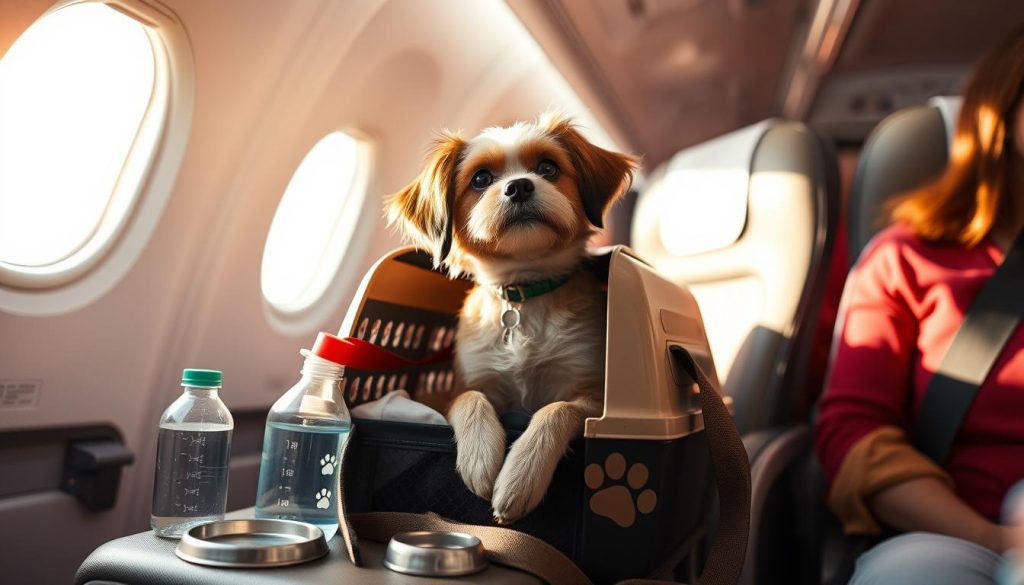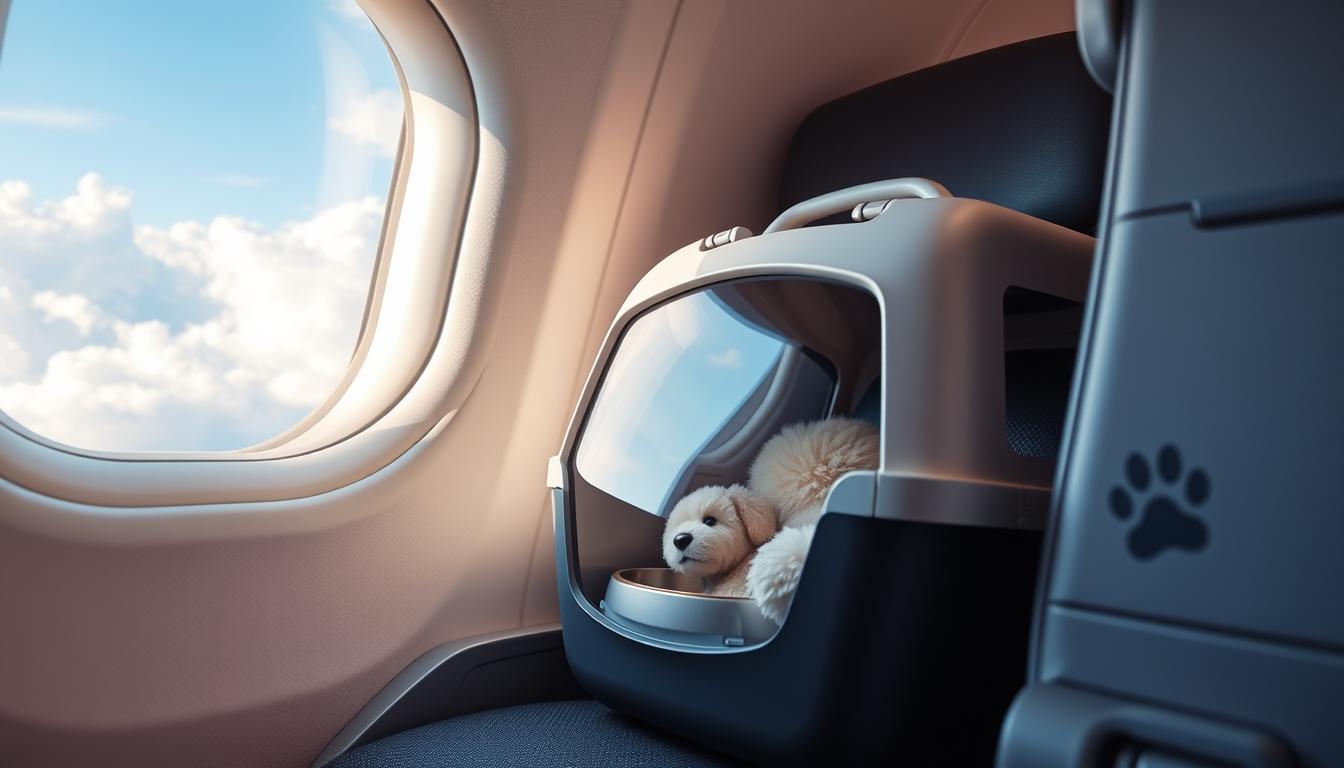As a pet owner, flying with your pet can seem tough. Over 2 million pets fly each year in the U.S., says the Department of Transportation. It’s key to know the rules for flying with your pet. This includes service animals, emotional support animals, size limits, and fees.
More pets are flying thanks to pet-friendly travel options. It’s vital for pet owners to keep up with the latest rules. This guide covers everything you need for a smooth trip with your pet, whether it’s in the U.S. or abroad.
Overview of Pet Air Travel

More pet owners want to take their pets on trips. This has made the pet travel market grow. Airlines now offer pet-friendly policies to meet this need.
Growing Demand for Pet-Friendly Travel
Over 60% of U.S. homes have a pet. This has led to a big increase in pet travel. People want airlines to let them take their pets on trips, for any reason.
Benefits of Allowing Pets on Flights
- Caters to the needs of the growing number of pet owners
- Enhances the travel experience for pet-loving passengers
- Provides an additional revenue stream for airlines through pet fees and charges
- Fosters a more welcoming and inclusive travel environment
Airlines have their own rules for pets on flights. But, they see the value in being pet-friendly. This trend is likely to keep growing as more pet owners want to take their pets with them.
General Rules and Regulations
Traveling with pets by air can be tricky, but knowing the rules helps. It’s important to understand about service animals and emotional support animals.
Service Animals and Emotional Support Animals
Service animals and emotional support animals can fly for free, thanks to the law. But, you must show proof from doctors or vets. You also need to show your pet’s vaccination records and might sign a waiver.
Each airline has its own rules for these animals. It’s smart to talk to the airline before flying. This makes sure you and your pet have a smooth trip.
Documentation and Vaccination Requirements
- Provide documentation from a licensed physician or mental health professional to verify the need for a service animal or emotional support animal
- Furnish proof of the animal’s up-to-date vaccinations, including rabies and other core vaccinations
- Be prepared to sign an indemnification or waiver form, as required by the airline
Knowing these rules helps pet owners deal with service animals, emotional support animals, and pet travel requirements. This makes flying with pets easier and less stressful.
pet airline regulations

Airlines have rules for pets to keep everyone safe and happy. It’s important to know these rules for a smooth trip with your pet.
Restrictions on Breeds and Sizes
Some pet breeds can’t fly because of health issues. Dogs with short faces, or brachycephalic breeds, have trouble breathing in the plane. Also, pets must fit in carriers that are 17 x 12 x 8 inches to 20 x 16 x 10 inches. Make sure your pet and carrier fit the airline’s pet size restrictions before you book.
Limitations on Number of Pets Per Flight
Airlines limit how many pets can fly together, often to five or seven per flight. This keeps everyone safe and comfortable. Check with your airline early to make sure your pet can fly with you.
Knowing the pet breed restrictions and number of pets per flight helps make flying with your pet easy and fun.
Carrying Pets in the Cabin

When flying with pets, picking the right pet carrier is key. This carrier will be your pet’s home in the sky. Make sure it meets the airline’s rules.
Airline-Approved Pet Carriers
The carrier must fit under the seat in front of you. It should let your pet stand, sit, and turn around. But, it can’t be too big. Soft-sided, collapsible carriers work well if they fit the size rules.
Before you book your flight, check the airline’s pet carrier rules. This makes sure your carrier is okay and travel goes smoothly.
Choose a carrier that keeps your pet safe and comfy. Knowing the airline’s pet rules helps make the flight good for you and your pet.
Checking Pets as Cargo
Transporting larger pets can be complex. They might need to be checked as cargo when flying. You must consider temperature rules and fees.
Temperature Restrictions and Embargoes
Airlines have strict rules for pets in the cargo hold. In extreme heat or cold, some airlines stop flying animals. This keeps pets safe. Always check these rules before booking to avoid surprises.
Fees and Charges for Checked Pets
Checking pets as cargo costs a lot. Fees can be $100 to $300 or more, based on the pet’s size and the airline. These fees add to the ticket price. Knowing about pet travel fees helps plan your budget. This makes pet cargo travel smoother.
Transporting pets as cargo takes some work. But with good planning, it can be safe and comfy. Always think about temperature restrictions for pet travel and plan your budget for pet travel fees. Being ready lets you enjoy your trip with your pet.
Preparing Your Pet for Air Travel
Traveling with a pet by air can be tough, but you can make it easier. Make sure your pet is healthy and stress-free for the flight. This means checking their health and finding ways to calm them down.
Health Checks and Veterinary Clearance
Before you book your flight, see your pet’s vet. They will check your pet’s health and give you the needed papers. This makes sure your pet is healthy for flying and spots any health issues that need extra care.
Strategies for Reducing Stress and Anxiety
Pets can get really stressed on a plane. Work with your vet to find ways to calm them down. Use calming collars, shirts, or supplements instead of sedatives. Also, get your pet used to the carrier and the sounds of flying to make the trip easier.
Preparing your pet well can make flying better for you and your pet. It’s all about their health and comfort.
Airline-Specific Pet Policies
As a frequent flyer, I’ve learned that each major U.S. airline has its own rules for pets. These rules cover what animals are allowed and the size of their carriers. It’s important for pet owners to check these guidelines before booking a flight.
Airlines like Alaska, American, Delta, Southwest, and United have their own pet policies. Travelers need to know these rules to make sure their pets have a smooth trip. Some airlines don’t allow certain breeds or sizes of pets. Others limit how many pets can fly together.
Understanding airline pet policies helps me plan better for my pet’s flight. This way, I can avoid surprises at the airport. It makes our trip together more enjoyable. Whether it’s a service animal, emotional support animal, or just a pet, knowing the airline’s rules is key for a smooth journey.

